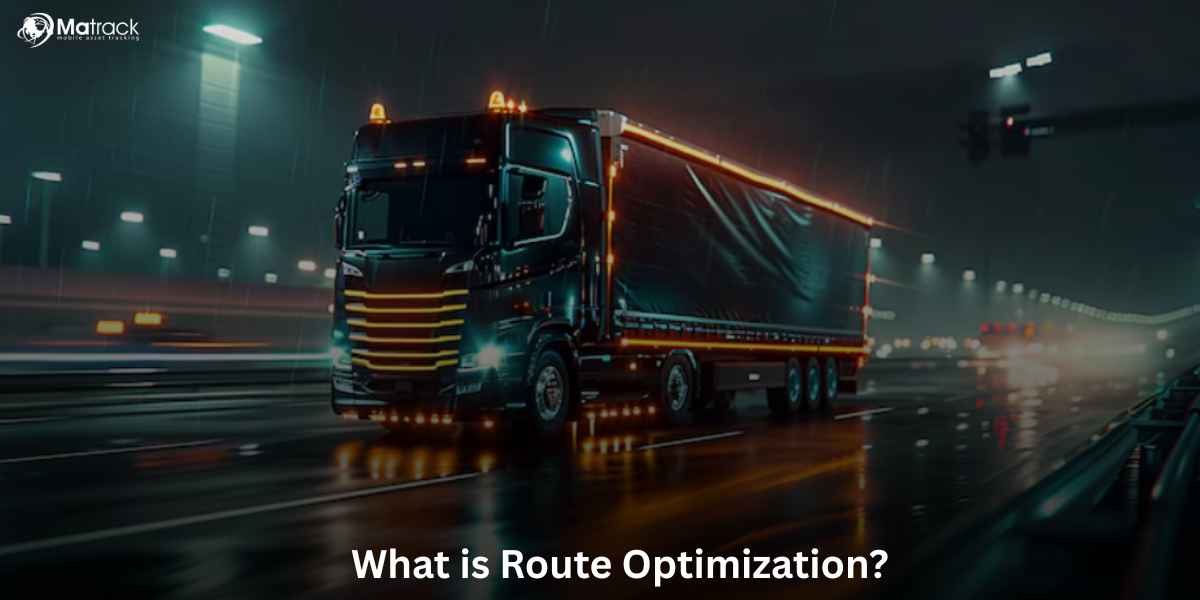Key Takeaways:
- Route optimization finds the most efficient way to complete deliveries using smart data and real-time conditions.
- It helps reduce costs, save time, cut emissions, and improve customer satisfaction across industries.
- Different types of route optimization solve unique challenges like time windows, vehicle limits, and multi-stop routes.
- Matrack improves route efficiency by tracking vehicles live, analyzing traffic, and highlighting driver performance.
What Is Meant By Route Optimization?
Route optimization is about finding the best way to get from one place to another while making the fewest stops and using the least time or fuel. It helps delivery drivers, service teams, and transport companies save time and money every day.
It works by using smart technology to check traffic, distances, and delivery times, then choose the most efficient path. This makes sure everything runs smoother and gets to the right place faster without wasting resources.
Why is Route Optimization Important?
Cutting Down Costs
When routes are well-planned, vehicles travel fewer miles. This helps reduce fuel costs, avoiding extra wear on vehicles, and making better use of drivers’ time. Over time, these savings add up and help businesses stay competitive.
Saving Time
Time is valuable, especially in delivery or service-based work. By avoiding traffic, choosing quicker roads, and grouping nearby stops, drivers get more done without rushing. This makes daily schedules easier to manage.
Supporting Sustainability
Fewer miles driven means fewer emissions released. Businesses can lower their environmental impact simply by driving smarter. It’s a practical step toward greener operations without needing major changes.
Keeping Customers Happy
No one likes late arrivals or vague updates. With accurate routing, customers get what they expect, on time and with clear communication. This builds trust and leaves a stronger impression with every interaction.
Technologies Behind Route Optimization Software
Geospatial Data and GPS
Geospatial maps and GPS tracking form the core of route planning. They help systems understand where vehicles are, where they need to go, and what roads connect them. With this foundation, routes can be created and adjusted as conditions change.
Traffic Intelligence
Real-time traffic updates allow routes to stay efficient even when conditions shift. Systems factor in live data about traffic jams, accidents, or road closures, and quickly adjust routes to avoid delays.
Optimization Algorithms
Special algorithms handle the heavy lifting behind the scenes. They calculate countless route combinations and find the ones that use the least time or distance, based on real-world constraints. These methods are designed to find the smartest path, not just the shortest.
Machine Learning Models
Machine learning adds an extra layer of intelligence. By studying past routes, delivery times, and driver habits, these models can spot patterns and improve future performance. They help predict delays, suggest better schedules, and fine-tune decisions over time.
Types of Route Optimization
Route optimization isn’t one-size-fits-all. Different situations call for different strategies depending on delivery schedules, vehicle loads, and service requirements. Here are the five most common types:
Static Route Optimization
Static routing uses fixed paths that stay the same each day. These routes are planned in advance and followed regularly, which works best when deliveries or stops don’t change much. Common examples include school buses, mail services, and recurring delivery routes.
Dynamic Route Optimization
Dynamic routing adapts to what’s happening in real time. It considers live traffic, weather updates, and new job requests to create the most efficient routes on the fly. This approach is widely used in food delivery, ride-sharing, and time-sensitive logistics.
Time-Window Route Optimization
Some deliveries or services need to happen at specific times. This method ensures that each stop falls within its required time slot while still finding an efficient path. It’s essential for handling items like fresh groceries, medication, or services that require appointments.
Capacity-Constrained Route Optimization
Every vehicle has its limits. This type of optimization accounts for weight, size, and load restrictions to prevent overloading and stay compliant with regulations. It’s a good fit for construction supply runs, industrial shipping, or bulk distribution.
Multi-Stop Route Optimization
When drivers need to make multiple stops in one trip, this strategy finds the most logical and efficient order. It reduces travel time between stops and helps teams complete more deliveries or tasks in a single route. E-commerce deliveries, field technicians, and courier services use this approach daily.
Challenges in Route Optimization
While route optimization improves efficiency, it’s not without its challenges. Real-world unpredictability, technical gaps, and business-specific needs often complicate the process.
Unpredictable Traffic
Even the best route can fall apart due to unexpected traffic jams, road accidents, or construction delays. Without real-time traffic updates and instant rerouting, delivery times can quickly slip out of control.
Last-Mile Delivery Complexity
Last mile of a delivery often presents the biggest obstacles. Driving in urban spaces, restricted entry points, and parking issues make it harder to stick to planned schedules. These small delays stack up fast, especially in high-density areas.
Data Quality Issues
Optimization tools rely heavily on accurate data. Wrong addresses, missing landmarks, or poor GPS coverage lead to inefficient routes and delivery errors. Clean, up-to-date data is the backbone of reliable planning.
Business Rule Conflicts
Route efficiency doesn’t always align with business needs. Things like driver familiarity with an area, customer time preferences, or working across multiple depots can force routes to be adjusted in ways that reduce efficiency.
Route Optimization in Different Industries
Route optimization plays a vital role across industries that depend on efficient movement and timely service. While the core technology remains similar, the way it’s used often depends on the specific needs of each sector.
Logistics and Supply Chain
In logistics, optimized routes help move goods from warehouses to stores or distribution centers on time. It improves delivery consistency, reduces transit delays, and supports smoother inventory management.
Food and Grocery Delivery
Fast delivery is key in food and grocery services. Dynamic routing helps match orders with drivers quickly and choose the fastest paths based on real-time conditions. This ensures freshness and keeps delivery times short.
Field Service Management
Companies offering repairs, maintenance, or inspections use route optimization to plan daily visits efficiently. It helps reduce travel time between appointments and increases the number of tasks completed per day.
Public Transport
Public transport systems use route planning to improve coverage and reduce waiting times. By analyzing passenger flow and traffic patterns, services can adjust routes to serve more people in less time.
Healthcare and Emergency Services
Every second counts in medical emergencies. Routing systems help prioritize urgent cases, choose the fastest paths, and guide emergency responders to their destination without delay.
How to Implement Route Optimization
Effective route optimization starts with the right strategy and tools in place. Follow these steps to build a system that improves efficiency and supports long-term results.
Collect and Clean Data
Start by gathering complete and accurate information. This includes delivery addresses, stop points, driver schedules, vehicle capacities, and any known constraints. Use mapping tools to verify locations and remove any errors.
Choose the Right Tool
Select a route planning solution that matches the size and needs of your operation. Consider how many routes you manage, how often they change, and what specific features you’ll need, such as real-time updates or vehicle tracking.
Define Operational Constraints
Every business has rules. Set clear limits such as maximum driving hours, service time at each stop, loading restrictions, and delivery time windows. Distinguish between essential constraints and those that are flexible.
Integrate with Existing Systems
Connect your routing system with other tools already in use. Link it to fleet management, customer databases, and GPS systems to ensure smooth data flow and accurate coordination.
Run Simulations
Before going live, test different route scenarios. Simulations can uncover hidden delays, inefficiencies, or conflicts in schedules, letting you make adjustments before they impact real operations.
Train Teams
Success depends on people understanding the system. Provide drivers and dispatchers with the right training, mobile tools, and user guides so they can follow routes easily and handle unexpected issues.
Monitor and Improve
Once in motion, keep a close eye on performance. Track delivery times, fuel usage, number of completed stops, and customer feedback. Use this data to fine-tune routes and improve over time.
Key Differences: Route Planning vs Route Optimization
| Feature | Route Planning | Route Optimization |
| Purpose | Defines a path | Refines the most efficient path |
| Data Use | Basic maps and locations | Traffic, weather, vehicle constraints |
| Algorithms | Simple path finding | Heuristics and AI models |
| Result | Feasible route | Optimal and cost-effective route |
Future of Route Optimization
- AI models will make self-improving decisions.
- Drones and robots will require 3D route logic.
- 5G will support real-time optimization with zero latency.
- Sustainability scoring will become a standard metric.
How Matrack Helps You Optimize Routes?
Matrack uses GPS fleet tracking to show where every vehicle is in real time. This helps plan quicker routes and avoid delays.
It checks traffic and road conditions to pick the fastest path. Drivers spend less time on the road and reach stops faster.
Matrack also shows how drivers are performing. Fleet managers use this to fix slow routes and save fuel.

